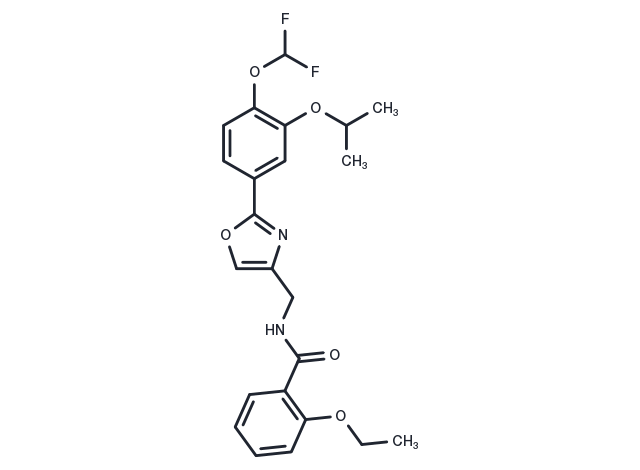Powder: -20°C for 3 years | In solvent: -80°C for 1 year


Difamilast is a selective inhibitor of phosphodiesterase-4 (PDE4) with particularly efficient inhibition of subtype B (IC50=11.2 nM).

| Pack Size | Availability | Price/USD | Quantity |
|---|---|---|---|
| 1 mg | In stock | $ 132.00 | |
| 5 mg | In stock | $ 328.00 | |
| 10 mg | In stock | $ 528.00 | |
| 25 mg | In stock | $ 859.00 | |
| 50 mg | In stock | $ 1,190.00 | |
| 100 mg | In stock | $ 1,580.00 | |
| 1 mL * 10 mM (in DMSO) | In stock | $ 363.00 |

| Description | Difamilast is a selective inhibitor of phosphodiesterase-4 (PDE4) with particularly efficient inhibition of subtype B (IC50=11.2 nM). |
| Targets&IC50 | PDE4B:11.2 nM |
| In vitro | Difamilast exerts inhibitory effects on PDE2[1]. |
| In vivo | In relevant animal models of AD, Difamilast improves skin condition [3]. |
| Molecular Weight | 446.44 |
| Formula | C23H24F2N2O5 |
| CAS No. | 937782-05-3 |
Powder: -20°C for 3 years | In solvent: -80°C for 1 year
DMSO: 100 mg/mL (223.99 mM)
You can also refer to dose conversion for different animals. More
bottom
Please see Inhibitor Handling Instructions for more frequently ask questions. Topics include: how to prepare stock solutions, how to store products, and cautions on cell-based assays & animal experiments, etc.
Difamilast 937782-05-3 Metabolism PDE PDE4 OPA 15406 Inhibitor atopic phosphodiesterase-4 OPA15406 Phosphodiesterase (PDE) OPA-15406 dermatitis subtype inhibit inhibitor
